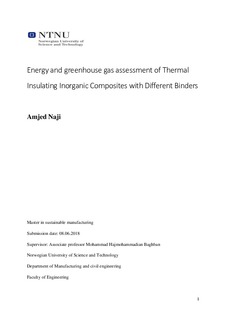| dc.description.abstract | In this thesis, it has been done further research of the new building composite materials with low thermal conductivity developed in NTNU & Sintef. The production of some new insulation composite materials has been studied to conduct the environmental impact of the production of these materials. The main aim was to conduct an LCA of these new composites compared to traditional insulation materials. Because of the lack of data from several components of these composites such as Aerogel and calcined clay, it wasn’t possible to do an LCA consist of LCA standards. Therefore, the aim is changed to do an energy and greenhouse climate analysis based on the available data in EPDs and Simapro. While for the components where there is no available LCA data, the claimed energy and CO2 equivalent from the producers were used. The thesis presents the energy consumption and CO2 equivalent of production of these composites.
Then compare them with the energy consumption and CO2 equivalent of production of the traditional insulation materials. By this comparing, it was possible to get a partial knowledge if these new composites are more environment - friendly solution to use the thermal insulation in the walls than the traditional insulation panels. These materials have high energy consumption and CO2 equivalent than the traditional insulation materials. The research considered the composites from AIC and AIM with 60 % aerogel content as multifunctional building materials which combine the low thermal conductivity and applicable strength to walls. This thesis has also made some conclusions which can be generalized to other composites. First, the aerogel reduces the energy consumption and CO2 of the production of Aerogel concrete aggregates because it reduces the density of the aggregate which reduces the amount of cement in the aggregate. Second, the replacement of cement by calcined clay will reduce the CO2 equivalent since the calcined clay low CO2 equivalent compared with cement. Then, the Silica fume has no environmental impact as co-product to the ferrosilicon. Therefore, the Silica fume reduces the environmental impact of concrete aggregates. The production of MKP has a higher environmental impact than the production of Portland cement. Therefore, the use of MKP as cement mass in the aggregates will increase the environmental impact of the aggregates. But it can reduce the environmental impact of the aggregate in the use phase by as energy saving based on their improved properties as strength and thermal conductivity. Finally, the fly ash will reduce the environmental impact of the aggregates since it defines as waste with no environmental impact. | nb_NO |
